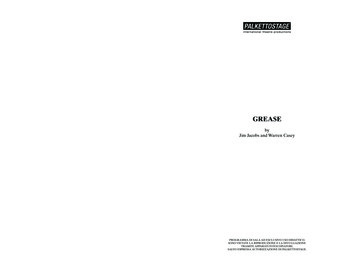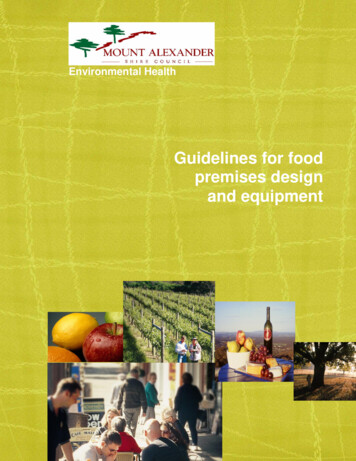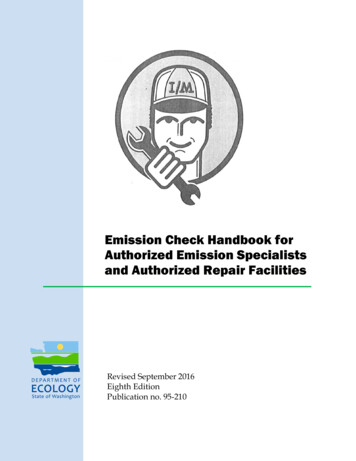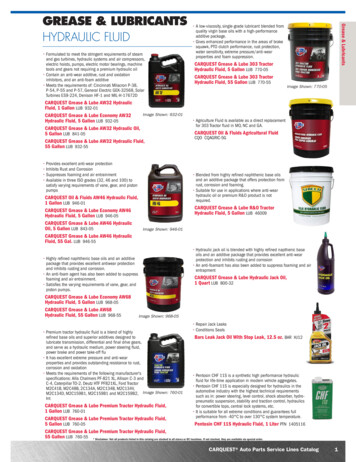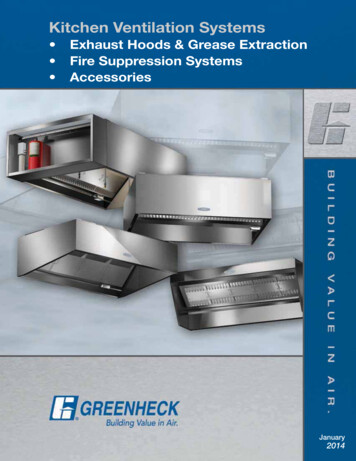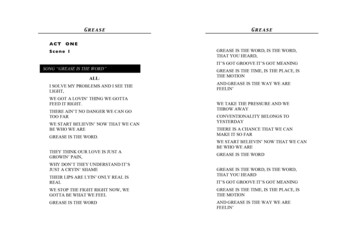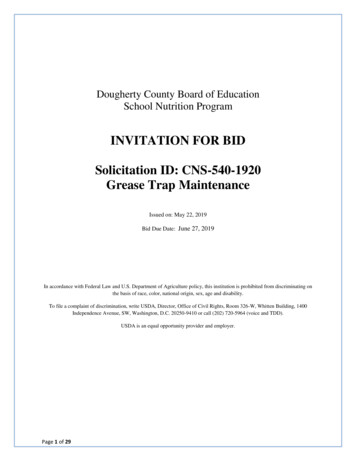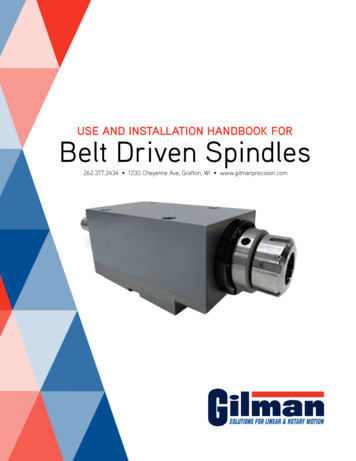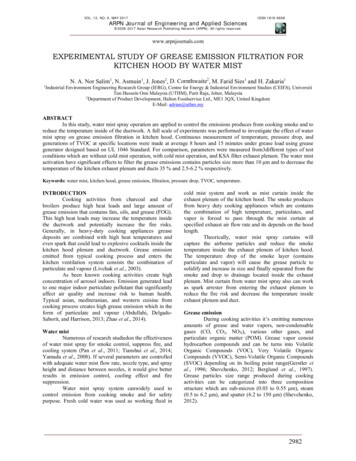
Transcription
VOL. 12, NO. 9, MAY 2017ISSN 1819-6608ARPN Journal of Engineering and Applied Sciences 2006-2017 Asian Research Publishing Network (ARPN). All rights reserved.www.arpnjournals.comEXPERIMENTAL STUDY OF GREASE EMISSION FILTRATION FORKITCHEN HOOD BY WATER MIST1IndustrialN. A. Nor Salim1, N. Asmuin1, J. Jones2, D. Cornthwaite2, M. Farid Sies1 and H. Zakaria1Environment Engineering Research Group (IERG), Centre for Energy & Industrial Environment Studies (CEIES), UniversitiTun Hussein Onn Malaysia (UTHM), Parit Raja, Johor, Malaysia2Department of Product Development, Halton Foodservice Ltd., ME1 3QX, United KingdomE-Mail: adrian@uthm.myABSTRACTIn this study, water mist spray operation are applied to control the emissions produces from cooking smoke and toreduce the temperature inside of the ductwork. A full scale of experiments was performed to investigate the effect of watermist spray on grease emission filtration in kitchen hood. Continuous measurement of temperature, pressure drop, andgenerations of TVOC at specific locations were made at average 8 hours and 15 minutes under grease load using greasegenerator designed based on UL 1046 Standard. For comparison, parameters were measured from3different types of testconditions which are without cold mist operation, with cold mist operation, and KSA filter exhaust plenum. The water mistactivation have significant effects to filter the grease emissions contains particles size more than 10 μm and to decrease thetemperature of the kitchen exhaust plenum and ducts 35 % and 2.5-6.2 % respectively.Keywords: water mist, kitchen hood, grease emission, filtration, pressure drop, TVOC, temperature.INTRODUCTIONCooking activities from charcoal and charbroilers produce high heat loads and large amount ofgrease emission that contains fats, oils, and grease (FOG).This high heat loads may increase the temperature insidethe ductwork and potentially increase the fire risks.Generally, in heavy-duty cooking appliances greasedeposits are combined with high heat temperatures andeven spark that could lead to explosive cocktails inside thekitchen hood plenum and ductwork. Grease emissionemitted from typical cooking process and enters thekitchen ventilation system consists the combination ofparticulate and vapour (Livchak et al., 2003).As been known cooking activities create highconcentration of aerosol indoors. Emission generated leadto one major indoor particulate pollutant that significantlyaffect air quality and increase risk to human health.Typical asian, mediteranian, and western cuisine fromcooking process creates high grease emission which in theform of particulate and vapour (Abdullahi, DelgadoSaborit, and Harrison, 2013; Zhao et al., 2014).Water mistNumerous of research studiedon the effectivenessof water mist spray for smoke control, suppress fire, andcooling system (Pan et al., 2011; Tianshui et al., 2014;Yamada et al., 2008). If several parameters are controlledwith adequate water mist flow rate, nozzle type, and sprayheight and distance between nozzles, it would give betterresults in emission control, cooling effect and firesuppression.Water mist spray system canwidely used tocontrol emission from cooking smoke and for safetypurpose. Fresh cold water was used as working fluid incold mist system and work as mist curtain inside theexhaust plenum of the kitchen hood. The smoke producesfrom heavy duty cooking appliances which are containsthe combination of high temperature, particulates, andvapor is forced to pass through the mist curtain atspecified exhaust air flow rate and its depends on the hoodlength.Theorically, water mist spray curtains willcapture the airborne particles and reduce the smoketemperature inside the exhaust plenum of kitchen hood.The temperature drop of the smoke layer (containsparticulate and vapor) will cause the grease particle tosolidify and increase in size and finally separated from thesmoke and drop to drainage located inside the exhaustplenum. Mist curtain from water mist spray also can workas spark arrester from entering the exhaust plenum toreduce the fire risk and decrease the temperature insideexhaust plenum and duct.Grease emissionDuring cooking activities it’s emitting numerousamounts of grease and water vapors, non-condensablegases (CO, CO2, NOX), various other gases, andparticulate organic matter (POM). Grease vapor consisthydrocarbon compounds and can be turns into VolatileOrganic Compounds (VOC), Very Volatile OrganicCompounds (VVOC), Semi-Volatile Organic Compounds(SVOC) depending on its boiling point range(Gerstler etal., 1996; Shevchenko, 2012; Berglund et al., 1997).Grease particles size range produced during cookingactivities can be categorized into three compositionstructure which are sub-micron (0.03 to 0.55 μm), steam(0.5 to 6.2 μm), and spatter (6.2 to 150 μm) (Shevchenko,2012).2982
VOL. 12, NO. 9, MAY 2017ISSN 1819-6608ARPN Journal of Engineering and Applied Sciences 2006-2017 Asian Research Publishing Network (ARPN). All rights reserved.www.arpnjournals.comFigure-1. Sketch of the test setup kitchen facilities.Grease emission produced from cookingactivities can be mixin vapor and particulate. In ASHRAE1375 final report studied the grease emission producedfrom various type of cooking appliances conducted withfull scale of experiment. The results shows that the greaseemission are dominated by vapor 60 - 90% followed by 10- 40% particulate in the exhaust duct and its depends onthe cooking operations. The highest grease emissions inthe exhaust duct are from solid fuel broiler test with 70%grease emissions are in vapour and 30% in particulate hasbeen reported(Kuehn et al., 2008).From previous research(Livchak et al., 2003), the emissions of grease particulatecomposition for gas broiler hamburger was 70%dominated and 30% are in vapor.Water mist versus mechanical grease filtersThe mechanical grease filters are installed to theexhaust plenum to capture particulate grease emissionproduced during cooking activities. There several types ofmechanical grease filters with different design andefficiency can be found in the market such as cyclonicfilter and baffle filter. Mechanical grease filters are closelyto 100% efficient to capture particles size more than 10μm but unable to extract vapor grease emissions (Livchaket al., 2003).Cooking activities produced heat that definitelywill increase kitchen ventilation temperature as well as tosurroundings. This mechanical grease filters are onlyeffective to capture particulate but not to cooling down orto prevent spark generated from heavy-duty cooking toentering exhaust duct. For heavy-duty cooking such aschabroiler, the water mist activation will not only to filterthe grease emissions, but functions as spark arrester and tocool down the kitchen ventilation system due to mistcurtain and from the temperature drop.During grease loading test, three different typesof filters were used and installed in the ducting system tostudy the effectiveness of water mist spray. These threefilters were efficiently capture at difference particles sizerange which are greater than 10 μm, greater than 1μm, andgreater than 0.01μm. Finally a comparison were made basefrom without water mist and with water mist testconditions.EXPERIMENTSExperimental setupThe full scale test kitchen hood with water mistexhaust plenum was carried out and the dimension of thehood and ducting system is similar with the ASTM F251905. A schematic diagram of the test setup is shown inError! Reference source not found. The watermist kitchen hood exhaust plenum used was manufacturedby Halton Foodservice.The type of water mist nozzles was used duringthis test is 1/8 KJSB 0.5 and was manufactured by JohnBrooks Company. Thereare 6 numbers of nozzles wasinstalled horizontally along 1219 mm kitchen hood lengthwith integration of 170 mm distance between nozzles asshown in Error! Reference source not found.Figure-2. Water mist spray (mist curtain) operated.The pressure of the working fluid was set to 1.60bar at water mist spray flow rate 0.29 l/min for eachnozzle. The K-type thermocouples and VOC sensors wereinstalled and labelled as in Error! Reference sourcenot found. for temperature measurements and gassampling. Continuous measurement of temperature,TVOC contamination, and filters pressure drop wererecorded using Pico Log recorder, KONTAR-Konsole,and Lrc Tester LHC1-MainUnit Filter System.2983
VOL. 12, NO. 9, MAY 2017ISSN 1819-6608ARPN Journal of Engineering and Applied Sciences 2006-2017 Asian Research Publishing Network (ARPN). All rights reserved.www.arpnjournals.comThree types of filters were used in this test tomass concentration of the particles and vapor pass throughthe exhaust ducts. The pre-filter, secondary filter, HEPAfilter, vegetable oil (grease machine), and water (greasemachine) were weighing before start and at the end of thetest. The air was supplied to the test room and the exhaustairflow was set at actual pressure 72 Pa at actual airflowrate range from 3000 to 3490 m3/hour.Grease loading testGrease machine was used as the grease loadingtest to create grease emissions. The grease machine andtest hood design and specifications is similar and complywith UL 1046, ASTM 2519-05 and NFPA 96requirements and standards.The loading pan of grease machine was preheatedto 385 C ( 14 C) and the thermocouple were placedinside the vapor box to monitor and maintaincontionuously the heating temperature. Then, followed byactivation of dripping the oil and water at flow rate of 10 0.5 ml/minute and 124.5 0.5 ml/minute respectively. Totest closely in physical and chemical properties of thecompounds emitted during cooking, the representative ofvegetable oil (0.92 g/ml) were used as the loadingmaterial.The grease loading test was conducted with threetest conditions. The first condition is without activation ofwater mist spray and followed by the second test conditionwith water mist (mist curtain) activation and the finalcondition using KSA mechanical grease filter plenumwithout water mist activation. The test was runcontinuously with same amount of vegetable oil and waterfor each test condition.Figure-3. Mass concentration from different 3 types offilters for two test conditions at durations of 8.25 hours.Test condition without water mist activationshow the highest mass concentration on the pre-filter. Theresults from both test conditions, it shows that the greaseloading test was dominated by 86.1 - 90.5 % particles sizegreater than 3 μm. From the observation during water mistactivation, some amount of water pass through into theexhaust duct and the filters captured the mixture of greaseand water particles and vapor. From visual observation onthe pre-filter after reached its maximum final resistance, itshows that the grease deposited more on the pre-filter usedfor test condition without water mist as in Error!Reference source not found.RESULTS AND DISCUSSIONSThe mass concentration for a grease emissionsample in the exhaust ducts were calculated as:C (Wf Wi)/V(1)Where C is the mass concentration in µg/m3.Wf and Wi are the final and initial weights of the filterused to collect the particles and vapor sample andmeasured in µg and V is the total air volume sampledthrough the filter in m3 along duration of 8.25 hours.Figure-3 shows the results for mass concentrationfrom 3 different type’s offilters during activation watermist system and without water mist activation undergrease load along 8.25 hours. The filter was installed todetermine how much the portion of particles andvaporpass through to the exhaust ducts. The pre-filter,secondary filter, and HEPA filter grade were used in thistest are 98% - 99.9% efficient to capture particles sizegreater than 10μm, 3 μm, and 0.3 μm.Figure-4. Pre-filter after reached maximum finalresistance (pressure drop).Exhaust duct temperatureThe average temperature of grease emissionssmoke layer before activation of mist spray at location T4and T6 were 55.62 C and 42.71 C respectively. For testcondition with water mist activation, the averagetemperature at location T6was 27.76 C. The mist sprayactivation test, the average temperature inside the exhaustplenum dropped to 35 % and the temperature at locationT8 (2/3 hood length) decreased 2.5 - 6.2 % as shown inFigure-5. Base on 3 test conditions, the small temperaturedrop occurred at location T8 due to the exhaust airflowtemperature effects.2984
VOL. 12, NO. 9, MAY 2017ISSN 1819-6608ARPN Journal of Engineering and Applied Sciences 2006-2017 Asian Research Publishing Network (ARPN). All rights reserved.www.arpnjournals.comFigure-5. Temperature variations for 3 test conditions atlocation 2/3 hood length.Figure-7. variation of secondary filter resistance.The continuous measurement on temperaturevariations for each test condition was conductedseparately. The water mist activation along durations of150 minutes shows us that the grease emissions smokelayer at location 2/3 hood length decreased compared toothers 2 test conditions. When the water mist activated, thecooling effects inside the exhaust duct was great atduration less than 50 minutes and almost no significanteffects at durations over than 50 minutes.Pressure dropEach filter has its own resistance limits. Themaximum resistance limits and particles arrestanceefficiency for each filter depends on the filter grades. Thecontinuous measurement was made where the manometertube was placed at before and after airflow direction foreach filter to measure static pressure different. Themeasurement was made continuously until one of the filterreached its resistance limits. At this time, the greaseloading and exhaust airflow were stopped and the filterwas replaced. Then, the test was continue immediatelywith brand new filter (weighted) and activation of thegrease loading and exhaust airflow.Figure-8. Variation of HEPA filter resistance.The pre-filter tested shows that the activation ofwater mist spray slow down the build up of the pressuredrop. The maximum resistance reached for the pre-filterdecreased to 16.7 % and its shows the significant effects ofwater mist activation to capture grease emissions particlessize greater than 10 μm as in Figure-6. The results fromFigure-7 and Figure-8 shows that the resistance from thepre-filter affected the resistance of the secondary andHEPA filter. There was some drop can be observed infilter resistance on secondary and HEPA filter right afterthe pre-filter was replaced. The secondary filter shows thatit slow down the build up of the pressure drop by 25 % at200 minutes sampling time.Figure-6. Variation of pre-filter resistance.Figure-9. Variation of pre-filter resistance for3 test conditions.2985
VOL. 12, NO. 9, MAY 2017ISSN 1819-6608ARPN Journal of Engineering and Applied Sciences 2006-2017 Asian Research Publishing Network (ARPN). All rights reserved.www.arpnjournals.comWater mist activation increased the watercontents (moisture) in the grease emissions smoke layersince the final weighing results show that the total filtersweight increased by 6.1 %. The amount of particles sizesmaller than 3 μm contains in the smoke layer in theexhaust ductsincreased23.5 % during activation of watermist system at 8.25 hours grease loading.Base on Figure-9it shows that the water mist activation and mechanicalgrease filter shows similarity in pre-filter resistancebetween 150 minutes grease loading. As results, watermist gives significant effect with mechanical grease filterto capture efficiently particles size greater than 10 μm.TVOC ContaminationThe TVOC sample was collected inside theexhaust ducts for 2 test conditions (with and without watermist activation) at 8.25 hours sampling time. The TVOCsample for KSA filters exhaust plenum also was carriedout for 150 minutes (maximum pre-filter resistance) forcomparison as in Figure-12.The results as in Figure-10 shows the TVOCcontamination for both test at location before pre-filter inthe exhaust ducts. For test condition without water mistactivation, the TVOC contamination rose sharply 29.8 %and achieved the peak values at average 711 ppm after 10minutes of sampling time. During water mist activation,the TVOC contamination rose 24.3 % and achieved thepeak values at average 707 ppm after 40 minutes ofsampling time. As results, it shows the water mistactivation has significant effects on TVOC contaminationfor less than 40 minutes sampling time.Figure-11 shows the TVOC contamination atlocation after HEPA filters in the exhaust ducts. Theresults show the similar effects at the sampling locationbefore pre-filters. The TVOC contamination decreased ataverage 17.1 % for test condition without water mistactivation and 18.6 % during water mist activation.The average total TVOC contamination at 150minutes sampling time for KSA exhaust plenum, withoutwater mist activation, and water mist activation was 656ppm, 621 ppm, and 627 ppm respectively as in Figure-12.As results, the highest TVOC contamination occurredfrom KSA exhaust plenum. However, base on Figure-10,Figure-11, and Figure-12 there is not much differents inTVOC contamination for all test.Figure-11. TVOC contamination at location after 3 filtersin the exhaust ducts.Figure-12. variation of TVOC contamination for3 test conditions.CONCLUSIONSThe tests via experiments conducted have shownthat the water mist system for commercial kitchen hoodhas significant effects to filter the grease emissions and toreduce the temperature inside the exhaust plenum andducts. Figure-10. TVOC contamination at location before 3filters in the exhaust ducts.Base on the mass concentration on the filters that haveexamined, water mist activation reduced the amountof particles size greater than 10 μm in the smoke layerto enter the exhaust plenum.The maximum resistance of the pre-filter extended by16.7 % which mean the water mist activation havesignificant effects as well as cyclone mechanicalgrease filter (KSA filter) where can capture 100%efficiently particles size more than 10 μm.The smoke temperature inside the exhaustductreduced due to the temperature drop occurred onthe smoke layer during penetrating water mistcurtains.The average TVOC contamination from 3 differentconditions test have shown similar results. But, thewater mist activation have shown great result atsampling time less than 40 minutes.ACKNOWLEDGEMENTThis research was supported by HaltonFoodservice Limited, United Kingdom and UniversitiTun2986
VOL. 12, NO. 9, MAY 2017ISSN 1819-6608ARPN Journal of Engineering and Applied Sciences 2006-2017 Asian Research Publishing Network (ARPN). All rights reserved.www.arpnjournals.comHussein Onn Malaysia in term of test facilities andfinancial supports.REFERENCESZhao Y. et al. 2014. Measurement of temperature, relativehumidity and concentrations of CO, CO2 and TVOCduring cooking typical Chinese dishes. Energy org/10.1016/j.enbuild.2013.11.037.Abdullahi K.L., Delgado-Saborit J.M. and Harrison R.M.,2013. Emissions and indoor concentrations of particulatematter and its specific chemical components fromcooking: A review. Atmospheric Environment. 71: 260294.ASTM 2519 - 05, 2005. Standard Test Method for GreaseParticle Capture Efficiency of Commercial Kitchen Filtersand Extractors.Berglund B. et al. 1997. Total Volatile OrganicCompounds (TVOC) in Indoor Air Quality Investigation.European CommIssion Joint Research Centre Environment Institute, (EUR 17675 EN). pp. 1-45.Gerstler W.D. et al. 1996. Identification andCharacterization of Effluents from Various CookingAppliances and Processes as Related To Optimum Designof Kitchen Ventilation System. ASHRAE 745-RP.Kuehn T.H. et al. 2008. Characterization of effluents fromadditional cooking appliances. ASHRAE 1375-RP.Livchak A. et al. 2003. The Facts Mechanical Grease.American Society of Heating, Refrigerating and AirConditioning Engineers ASHRAE Journal.NFPA 96, 2001. Standard for Ventilation Control and FireProtection of Commercial Cooking Operations. NFPAInternational, MA 02269-9(USA).Pan L.W. et al. 2011. Experimental study of smoke controlin subway station for tunnel area fire by water mistsystem. Procedia Engineering. 11: 335-342.Shevchenko N. 2012. Problem of Grease and its Solutionsin Commercial Kitchens. Mikkeli University of heseus.fi/bitstream/handle/10024/49319/Natalia Shevchenko.pdf?sequence 1.Tianshui L. et al. 2014. An Experimental Study on theInteraction of Water Mist with Vertical/Horizontal SprayFlame. Procedia Engineering, 84, pp. 543-552. e/pii/S1877705814017871.UL 1046, 2010. Grease Filters for Exhaust Ducts.Underwriters Laboratories Inc. Standard for Safety.Yamada H. et al. 2008. Study of cooling system withwater mist sprayers: Fundamental examination of particlesize distribution and cooling effects. Building Simulation.1, pp. 214-222.2987
The full scale test kitchen hood with water mist exhaust plenum was carried out and the dimension of the hood and ducting system is similar with the ASTM F2519-05. A schematic diagram of the test setup is shown in Error! Reference source not found. The water mist kitchen hood exhaust plenum used was manufactured by Halton Foodservice.
